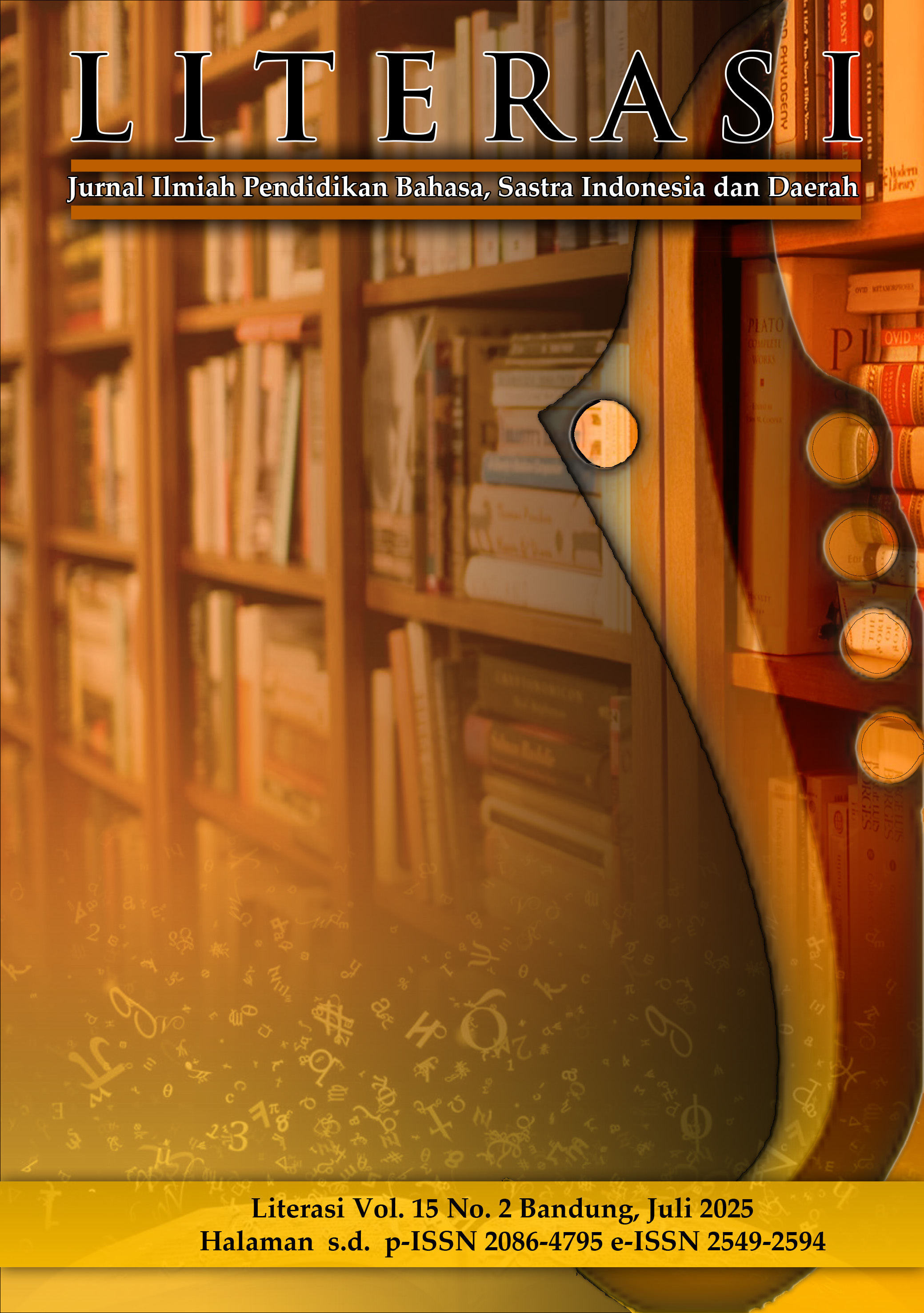DENDAM PEREMPUAN: PERBANDINGAN THE CURSE OF LA LLORONA DAN MARNI: THE STORY OF WEWE GOMBEL DALAM REPRESENTASI FILM HOROR
DOI:
https://doi.org/10.23969/literasi.v15i2.24046Keywords:
feminisme radikal, film horor, dendam perempuanAbstract
Film horor seringkali merepresentasikan perempuan sebagai korban atau entitas yang menakutkan, yang melawan ketidakadilan. The Curse of La Llorona dan Marni: The Story of Wewe Gombel menggambarkan perempuan yang mengalami ketidakadilan sosial dan bertransformasi menjadi makhluk supranatural sebagai bentuk perlawanan. Penelitian ini mengkaji representasi perempuan dalam kedua film tersebut melalui pendekatan feminisme radikal MacKinnon untuk memahami posisi perempuan yang tidak memiliki akses keadilan dalam sistem patriarki, serta alternatif yang ditempuh di luar norma hukum. Metode yang digunakan adalah analisis deskriptif-naratif terhadap dialog yang menggambarkan motif dendam perempuan. Hasil penelitian menunjukkan bahwa La Llorona dan Marni menjadi simbol perlawanan terhadap sistem patriarki, meskipun motif dan cara keduanya berbeda. La Llorona mengalami kehilangan anak akibat pengkhianatan dan stigma sosial, yang memotivasi untuk membalas dengan menculik anak-anak lain. Di sisi lain, Marni mengalami kekerasan seksual dan penghakiman sosial, yang mengarahkannya untuk membunuh pelaku sebelum bertransformasi menjadi Wewe Gombel yang melindungi anak-anak terlantar. Perbedaan tersebut mencerminkan pengaruh mitos dan budaya dalam membentuk ekspresi perlawanan perempuan terhadap ketidakadilan gender.
Downloads
References
Ahmadi, A. (2021). The Traces Of Oppression And Trauma To Ethnic Minorities In Indonesia Who Experienced Rape On The 12 May 1998 Tragedy: A Review Of Literature. Journal of Ethnic and Cultural Studies, 8(2), 126–144. https://doi.org/10.29333/ejecs/744
Aleksić, T. (2024). Trauma, Memory, And The Politics Of Mourning In New Albanian Film From Kosovo. Studies in Eastern European Cinema, 0(0), 1–21. https://doi.org/10.1080/2040350X.2024.2371617
Amin, S. (2024). Feminist Witnessing: Everywhere All At Once: Coercive Control and the Impacts of Feminist Law Reform Efforts on Popular Culture. Australian Feminist Law Journal, 50(1), 49–64. https://doi.org/10.1080/13200968.2024.2366776
Anderson, A., Chilczuk, S., Nelson, K., Ruther, R., & Wall-Scheffler, C. (2023). The Myth Of Man The Hunter: Women’s Contribution To The Hunt Across Ethnographic Contexts. PLoS ONE, 18(6 June), 1–11. https://doi.org/10.1371/journal.pone.0287101
Andini, M. (2023). Badarawuhi : Representsi Monstrous Feminine dalam Film KKN di Desa Penari (2022). Cinematology: Journal Anthology of Film and Television Studies, 3(1), 122–132.
Annissa, L. W., & Adiprasetio, J. (2022). Ketimpangan Representasi Hantu Perempuan Pada Film Horor Indonesia Periode 1970-2019. ProTVF, 6(1), 21. https://doi.org/10.24198/ptvf.v6i1.36296
Astutik, F., & Setiadi, T. (2024). Representasi Maskulinitas Perempuan Dalam Film Seperti Dendam, Rindu Harus Dibayar Tuntas. The Commercium, 8(3), 174–186. https://doi.org/10.26740/tc.v8i3.63474
Azizah, N., & Rahayu Z, S. P. (2023). Perempuan dalam Film Horor Indonesia dari Perspektif Psikologi. Ad-Dariyah: Jurnal Dialektika, Sosial Dan Budaya, 3(2), 129–142. https://doi.org/10.55623/ad.v3i2.127
Beck, V., & Rose, C. (2021). Is Sexual Objectification and Victimization of Females in Video Games Associated With Victim Blaming or Victim Empathy? Journal of Interpersonal Violence, 36(5–6), NP3196–NP3221. https://doi.org/10.1177/0886260518770187
Carless, F. T. (2024). This is a Female text”: The Mediumship of Creative Histories in Doireann Ní Ghríofa’s A Ghost in the Throat. Women’s Studies, 53(4), 456–467. https://doi.org/10.1080/00497878.2023.2278166
Creswell, J. W., & Creswell, D. J. (2021). Research design: Qualitative, quantitative, and mixed methods approaches. SAGE Publications.
Crofts, P., & van Rijswijk, H. (2024). Final Fatal Girls–Horror and the Legal Subject. Australian Feminist Law Journal, 50(1), 113–129. https://doi.org/10.1080/13200968.2024.2333541
Darni, D., Lestari, Y., Ernawati, Y., Ubaidillah, U., Subandi, S., Zahro, A., Rahman, N. A., & Apriyani, D. (2023). Discrimination of Women in Modern Javanese Novels. IJCAH, 1, 1557–1565. https://doi.org/10.2991/978-2-38476-008-4_168
Dewi, N. (2020). Kekerasan, Balas Dendam, dan Pengkambinghitaman dalam Tiga Cerpen Indonesia. JENTERA: Jurnal Kajian Sastra, 9(1), 43. https://doi.org/10.26499/jentera.v9i1.1755
Echols, A. (1989). Daring to Be Bad: Radical Feminism in America 1967-1975. University of Minnesota Press.
Farrelly, M. (2021). A Work Of Death: Martyrdom, Myth And Dead Women In Contemporary Spanish Film. Journal of Spanish Cultural Studies, 22(1), 77–93. https://doi.org/10.1080/14636204.2021.1880785
Febrianto, D., & Tjahjandari, L. (2023). Representasi Kekerasan Terhadap Perempuan Dalam Ekranisasi Novel Seperti Dendam , Rindu Harus Dibayar Tuntas. Adabiyyat: Jurnal Bahasa Dan Sastra, VII(2), 154–177. https://doi.org/https://doi.org/10.14421/ajbs.2023.07022
Handayanti, A., Septadinusastra, V. A., Rahayu, A. S., Haryadi Mujianto, & Neni Yulianita. (2024). Gender Representation in True Story Television Film. Jurnal Spektrum Komunikasi, 12(1), 145–156. https://doi.org/10.37826/spektrum.v12i1.636
Hooks, B. (2000). Feminist Theory: From Margin to Center. South End Press.
Hooper, V. (2022). The Horrors of June: The Hope of November. Vote for the Women in Your Life. Journal of Perianesthesia Nursing, 37(5), 579–580. https://doi.org/10.1016/j.jopan.2022.08.001
Johnson, J. M., & Rowlands, T. (2023). The Craft of Qualitative Research Interviewing: Ethnographic and Narrative Approaches. SAGE Publications.
King, N., & Horrocks, C. (2021). Interviews In Qualitative Research. SAGE Publications.
Kurnaiawan, Y. (2023). Mistikasi dalam Urban Legend: Film Horor di Indonesia Pasca Orde. Jurnal Ceteris Paribus, 2(1), 36–45. https://doi.org/10.25077/jcp.v2i1.19
MacKinnon, C. A. (1987). Toward a Feminist Theory of the State. Harvard University Press.
MacKinnon, C. A. (1991). Reflections on Sex Equality. Harvard Law Review.
Miguélez-Carballeira, H. (2024). The traumatic rural unconscious in contemporary Galician culture: hydropolitical violence in literature and film. Journal of Spanish Cultural Studies, 25(4), 549–564. https://doi.org/10.1080/14636204.2024.2421449
Phukan, B. J. (2024). Screening trauma and violence: Representation of insurgency in select films from Assam. South Asian Popular Culture, 22(1), 103–119. https://doi.org/10.1080/14746689.2024.2330186
Raharjo, R. P., Suyatno, S., Ahmadi, A., & Nugraha, A. S. (2025). Mysticism in the Myth of the Safety Forest as a Value of Student Character Education : a Case Study of Wonosalam Village , East Java (Vol. 2024, Issue Ijcah 2024). Atlantis Press SARL. https://doi.org/10.2991/978-2-38476-317-7
Rens, D. Van. (2023). “This Ain’t the Way It’s S’posed to Be”: Negotiating Trauma Through Postmemory and Implication in Yaa Gyasi’s Homegoing. English Studies, 104(5), 766–788. https://doi.org/10.1080/0013838X.2023.2234218
Rollero, C., & De Piccoli, N. (2020). Myths About Intimate Partner Violence And Moral Disengagement: An Analysis Of Sociocultural Dimensions Sustaining Violence Against Women. International Journal of Environmental Research and Public Health, 17(21), 1–11. https://doi.org/10.3390/ijerph17218139
Sakina, C. D., & Purba, E. R. (2022). Mitos Dan Paradoks Diskursus Perempuan Dalam Film Horor Kuime (Over Your Dead Body). Satwika : Kajian Ilmu Budaya Dan Perubahan Sosial, 6(2), 366–383. https://doi.org/10.22219/satwika.v6i2.22952
Simeunović Patić, B. (2021). Blaming Sexual Violence Victims In The Context Of Internalized Sexism And Female Intragender Hostility. Sociologija, 63(4), 688–707. https://doi.org/10.2298/SOC2104688S
Sutandio, A. (2023). The Final Girls In Contemporary Indonesian Horror Films: Reclaiming Women’s Power. Cogent Arts and Humanities, 10(1). https://doi.org/10.1080/23311983.2023.2186593
Tong, R. (2009). Feminist Thought: A More Comprehensive Introduction. Westview Press.
Topping, M. (2024). Exploding Myths of Female Desire for the Twenty-First Century: The Bacchantes of Euripides, Proust, and Minard. Women’s Studies, 53(4), 415–431. https://doi.org/10.1080/00497878.2023.2267155
Widodo, J., Anggraini, P., Zahidi, M. K., & Nuryasin, M. (2024). Representation Of Violence Against Female Characters In Indonesian Horror Novels. Journal Of World Science, 3(11), 1481–1490. https://doi.org/10.58344/jws.v3i11.1230
Ziegler, M. (2021). For Fear To Be Infect’ Reading The Female Body In Early Modern Revenge Drama. Journal of Early Modern Studies, 10, 249–267. https://doi.org/10.13128/jems-2279-7149-12550
Downloads
Published
Issue
Section
License
Copyright (c) 2025 Literasi: Jurnal Ilmiah Pendidikan Bahasa, Sastra Indonesia dan Daerah

This work is licensed under a Creative Commons Attribution 4.0 International License.
Hak cipta artikel yang diterbitkan di jurnal ilmiah dimiliki oleh penerbit, bukan penulis. Hal ini berkaitan dengan koordinasi hak akses untuk cetak ulang atau penggunaan lainnya. Dalam hal ini penerbit mempunyai keluluasaan untuk mempublikasikan artikel sesuai dengan kesepakanan Transfer Agreement (penyerahan hak cipta) antara penerbit dengan penulis.















